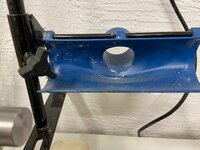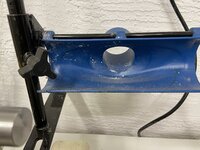Using a PSI dust collector with a 4" flex tube. I'd like the split the intake with a "Y" connector and use 2 2" flex hoses to 2 lathes. Would cap the unused lathe hose. Any reason why smaller diameter hoses can't be used...... I realize 4" is used for a reason but would like to swap. Thanks, Frank
You might want to look into how dust collectors work to get a clearer understanding (oneida air systems has a lot of great info on their site!)
In short, though: The larger diameter hose is actually going to have much greater airflow and volume moving capacity than a smaller diameter, and will collect significantly more chips, but more importantly more dust. The smaller the diameter of the opening, and more so the hose, the greater the losses to moving all the dust and chips around.
I am in the market for a dust collector myself, but I like to know the underlying theory before I buy something like that. In my recent research, I've found that airflow (usually listed as FPM or linear feet per minute) is the core value...the more powerful the collector, the greater the FPM in a general sense. The ducting and hoses used in the system all serve to increase static pressure, which is basically what we call the resistance to that airflow. The greater the resistance, the lower the actual volume of air (and dust and chips, the CFM or cubic feet per minute) pulled off your tool and through the system to the DC.
Smaller diameter ducting and hoses increase static pressure, lower volume, and reduce the effectiveness of the system at capturing EVERYTHING coming off your tools. The hardest thing to capture, according to my research, is the fine dust particles...but, it is fundamentally the fine dust particles we are really trying to capture! (At least, that is for me...I have been working solely with an overhead air filter and a shop vac so far, and my entire garage is just building up a deeper and deeper layer of dust the longer I work in my garage workshop without a dust collector...the shop vac ain't anywhere close to capable of pulling enough volume to actually capture much of anything as I've found.)
To capture all the dust, you need to maintain a minimum (IIRC) 3600 FPM over horizontal ducting, and 4500 FPM over vertical ducting and flexible hoses. Ideally you want more than that, to make sure you don't drop below the minimum, and the more 90 and 45 degree elbows you have in your ducting, the more you will need as each of those diminishes the airflow by a certain amount. For each kind of device you might be collecting dust at, the minimum CFM changes. A table saw needs around 450CFM, bandsaw maybe 380-400CFM. For lathes, I've found different numbers. Some say 400-430CFM, others say you need more like 600-650CFM. I think the difference is how much dust you are really trying to collect, and just how fine it is...the finer the dust, it seems the higher the CFM you need. With a lathe, you can produce some darn fine dust, whereas a tablesaw is going to be more chunky particles, a bandsaw more moderate dust. With pens in particular, especially sanding up to 3000 grit or more, the fineness of the dust gets rather extreme...I've found my little shop vac hardly sucks in any of the super fine dust...it just gets suspended in the air strait off the blank. The air filter eventually collects a lot of that...the rest just settles.
Anyway...restricting the airflow at the lathe will, IMO, decimate your ability to collect all the dust. You might still find the chips get captured, some dust, but you could find that the super fine stuff just suspends strait into the air and settles after a while. Whenever I watch turning videos, the ones where I actually really notice the dust collection, is when people drop a monster 6" or even 8" hose right at the lathe. I've seen some guys do some major sanding jobs on some large bowls and vases...and you can see every single grain of dust get sucked RIGHT into those huge hoses. Its rather amazing! I've never seen the same with 4" or smaller hose. DC horsepower does play a role here, but you can still decimate the machine-end CFM and airflow by using the wrong (too small) ducting, too many elbows, too many reductions, etc.
My recommendation is, split the hose, and put some blast fences or 4" caps on the 4" hose. Don't reduce it. In fact, if you really want the best collection, getting a nice wide neck to attach to the hose, could help capture more of the stuff that flies off at an angle or falls strait off the lathe, so it can still be captured by the airflow.


